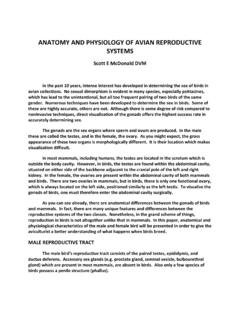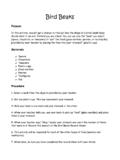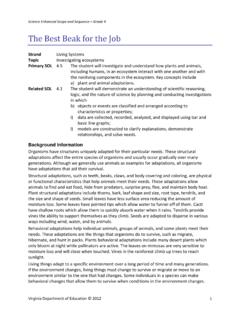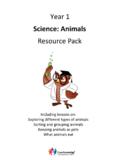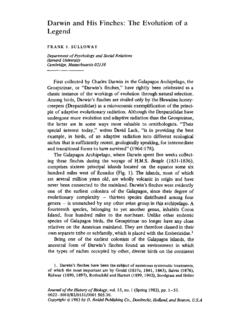Transcription of Bad Beaks Text - Scott E. McDonald
1 BAD Beaks A PICTORIAL Key Point: No matter how deformed or overgrown a beak appears, it almost never prevents a bird from eating. Introduction The beak includes the bones of the upper and lower jaws and their keratinized sheaths or rhamphotheca. This horny covering functionally replaces the lips and teeth. There is tremendous variation in the shape of the beak depending on how different species feed and live. In psittacines, the upper beak is massive and curved, whereas the lower beak is small and horse shaped. This is why parrots are called hook bills. A parrot s beak is adapted to cracking large nuts and seeds as well as tearing and shredding wood from trees to provide nest sites.
2 It is also used for grasping, climbing, preening, and displaying. It can be a formidable weapon yet also function as a delicate utensil for feeding newborn chicks. Microscopically, the horny beak resembles skin, consisting of dermis and a modified epidermis. The epidermis is very thick and its cells contain free calcium phosphate and hydroxyapatite crystals, in addition to abundant keratin. This is what helps make the beak so hard. Keratin is an insoluble protein and is the principal constituent of the epidermis in hair, nails, and the beak. The outer layers of the beak are continuously being replaced by normal wear and tear.
3 Many bird owners erroneously believe that the upper beak grows from the cere and continues to the tip (or edges) where it is then worn off (likewise with the lower beak). On the contrary, beak tissue grows continuously outward (towards the surface) over much of the beak. As the keratinized epithelium reaches the surface, it is either worn off or may move distally a short distance before it is lost. Only towards the edges and tip does the beak tissue truly move rostrally. The surface of the beak in juvenile parrots is smooth because the growth is new. However, as the bird reaches its first year and older, the beak takes on a more irregular appearance.
4 This is a result of the normal wearing off of the outer keratin layers. Sometimes these layers flake off or peel, leaving behind ledges on the beak s surface. These ledges are what make the beak look rough and scaly. These ledges can also be misinterpreted as cracks, which they are not. How irregular a bird s beak appears can also be related to diet. A diet low in vitamin A (seeds lack Vitamin A) can lead to hyperkeratosis, which clinically causes the beak to become thickened and overgrown. Such Beaks can appear very scaly. The beak can also appear rough if the bird does not adequately rub it on hard inanimate objects, such as a lava stone or concrete and sand perches.
5 Part of the physical examination of each bird includes an evaluation of the beak. Most healthy parrots have Beaks in which the surface is slightly irregular and the tip a bit long. Such birds often receive a cosmetic beak trim. A cosmetic trim is not necessary for the health of the bird, but by doing so, the bird looks better, which in turn makes the client more appreciative. Some birds have a pathologic condition which can change the normal outward appearance of the beak and affect some beak functions. In such cases corrective beak trimming is necessary. Aside from losing the entire upper or lower beak due to traumatic injury, overgrowth or deformity of the beak rarely affects a bird s ability to eat.
6 Beak trimming is accomplishing using a variety of tools, including human nail trimmers, cuticle cutters, and a hobby tool (Dremel). The preferred dremel tool is electric and variable speed. A course conical grinding stone (#952) is the only bit this author uses no matter the size of the patient. Dremel tools and accessory stones are inexpensive ($69 and $3) and can be purchased at Wal Mart, Home Depot, Lowe s, and most other hardware stores. Anesthesia (isoflurane gas) is not required for beak trimming, but it sure makes it easier and less stressful, both for the veterinarian and his assistant, and for the bird.
7 One should be aware that fully awake birds can stress easily during this procedure, especially when using a dremel tool, and deaths have been reported. Birds are usually held in a towel. One should also be very careful not to compress the bird too tightly which can adversely affect breathing and heart rate. The following photographs show vivid examples of normal and abnormal Beaks that were seen by the author. Figs 1 and 2: Trimming a bird s beak during a routine examination. Face masks are worn to prevent inhalation of beak dust. The bird s body is held with a towel by an assistant.
8 The vet secures the head with one hand and with the other, holds a dremel tool which is used to smooth out the beak surface and edges. Figs 3 and 4: Blue crowned conure showing a typical cosmetic beak trim. In the first picture, the beak surface appears a little rough and scaly and the tips are a bit long. After trimming the surface is smooth and the edges cleaned up and shortened. The beak appears shinny due to the application of mineral oil. Fig 5: HYPERKERATOSIS Red headed Amazon parrot. 25+ years old and fed a diet of seeds only. Hyperkeratosis due to low vitamin A has caused thickening of the upper beak.
9 Notice the two beak layers towards the inner layer is the normal one. Yellow feathers on head are abnormal due to malnutrition. Fig 6 and 7: Red headed Amazon parrot with severe overgrowth of the upper beak, before and after trimming. Bird fed seed diet only. Bird was still able to eat. Notice that the lower beak is normal. Seeds are hulled using the front of the lower beak edge against the underside of the upper beak. Fig 8 and 9: Examples of beak hyperkeratosis due to malnutrition related to Fatty Liver Disease in a Quaker parakeet and Blue and Gold macaw. Both birds were overweight.
10 The macaw s beak has become necrotic. Fig 10 and 11: Severe beak hyperkeratosis with necrosis in a Severe macaw that was grossly overweight. Notice fatty tumors in abdominal region of this obese bird. Fig 12 and 13: Two other examples of severe hyperkeratosis in a Blue fronted Amazon and a Double Yellow headed Amazon parrot. The Yellow headed parrot also has keratinization on the underside of the tongue. This condition is known as Woody Tongue. Fig 14 and 15: TRAUMA TO THE BEAK. Baby birds are prone to mutilation by their parents. If 1/3 of the beak or less is removed, the beak will grow back normally.
